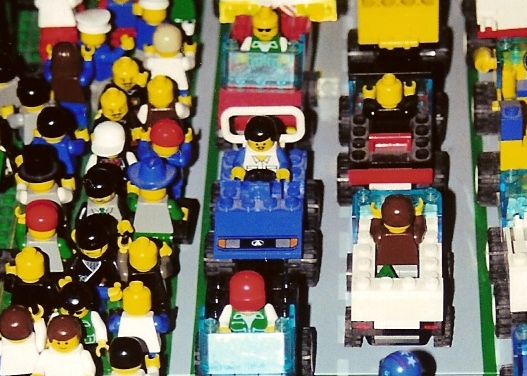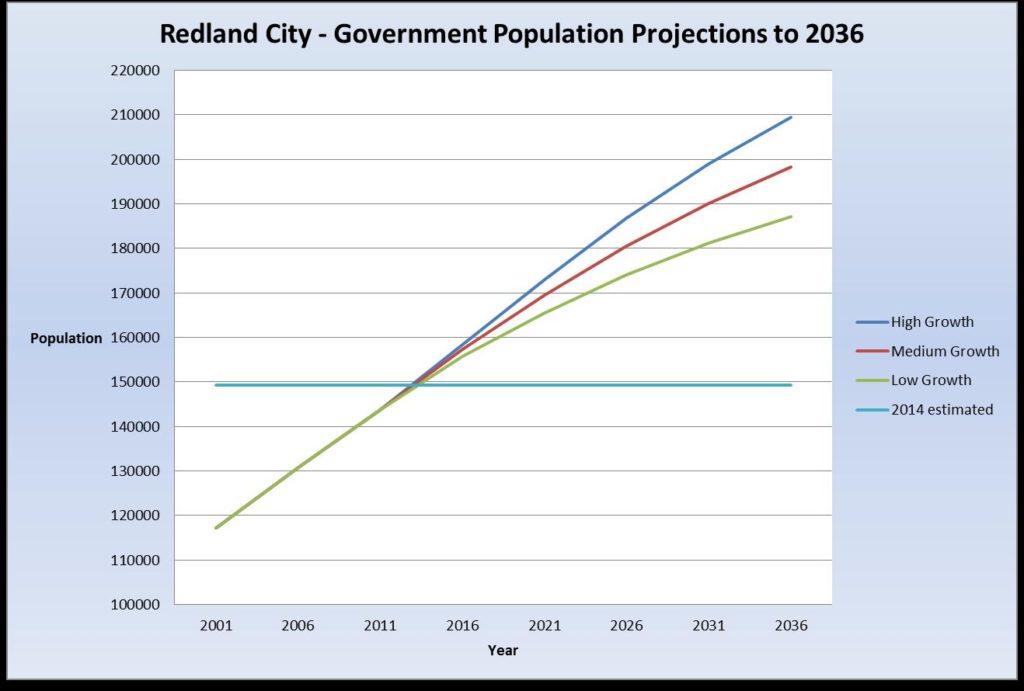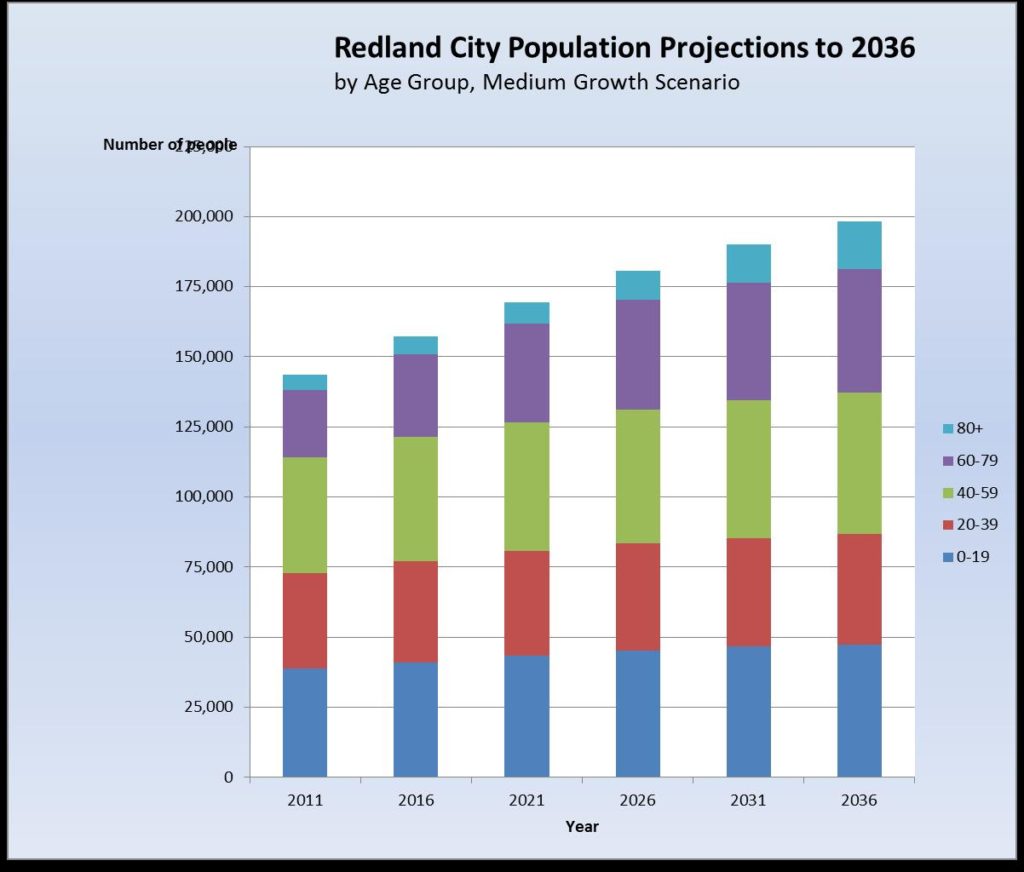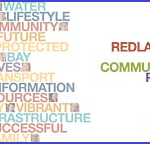
When Redland City’s population increases by 50,000, where will our residents live, work and play? This question is not adequately dealt with in the draft Economic Development Strategy released by Council for public review.
Presented below are some thoughts on the City’s projected population increase, trends in the City’s age profile and implications for the City’s planning scheme and economic development strategy.
Forecasting Redland City’s population increase?
The Queensland Government Statistician’s base case (Medium) projection is that by 2036 our City’s population will grow to 198,000 residents. This increase of about 50,000 or 33% is equivalent to average growth of 1.3% per year. Alternative (Low and High) projections range from 187,000 to 209,000. These official projections were published in 2013.
The chart below shows how these High, Medium and Low projections compare with Redland City’s current population of 149,000.
The Government’s projections assume that the rate of growth will decline slightly over time. Possibly, the Government Statistician thinks that fertility and immigration rates will decline in future years. Alternatively, land availability assumptions may limit growth. Or perhaps the growth rate is arbitrarily trimmed to avoid very big population numbers in later years. Redland City’s population would double in less than 50 years if we extended the 1.5% per year growth rate between 2016 and 2021, used by the Government in its Medium series projection.
There will be lots more older people in Redland City
The age profile of the Redlands population will change a lot over the next two decades. Data from the Government’s Medium series forecast is available in age groups.
Using this data we have produced a chart which shows that there will be a significant increase in the number of older people in the Redlands.
The number of people in the 60-79 age group will nearly double and there will be a dramatic increase in the number of people aged over 80. The number of people in age bands below 60 will increase very little.
Managing growth for improved outcomes
Redland City has some scope to influence the rate at which its population increases.
If the community thought that it would be desirable to have a population growing very rapidly then the City Council could do things like:
- Facilitate more land being available for housing
- Encourage higher density accommodation by having fewer planning controls
- Invest in marketing campaigns to attract more people to move into this area
On the other hand, the community could require the Council to trim population growth for various reasons such as:
- Ensure that quality of life is maintained through less “crowding”
- Avoid impacts on areas with high environmental values
- Reduce community investment in infrastructure required whenever new residential accommodation is built
To illustrate the impact of taking a proactive approach we consider a Reducing Growth scenario. This is based on the assumption that growth for the five years to 2016 will average 1.2% per year but for each later five year period, growth will be reduced by 0.2%. So by the time we get to 2031, growth will be about 0.4% per year.
A Reducing Growth strategy could be implemented through measures such as restricting new greenfield developments and ensuring limits on the density of infill residential accommodation. This would mean that by 2036 there might be only 26,000 additional people in Redland City compared with the 50,000 extra people forecast in the Government’s base case projection.
A “Rapid Growth” scenario is also examined, using annual population growth of 1.8% per year like Redland City has experienced in recent times. Under this “Rapid Growth” scenario, Redland City’s population in 2036 would increase by 73,000 or 49%.
The Reducing Growth and Rapid Growth scenarios are charted below, together with the Government’s base case Medium series projection shown in the first chart. This chart shows a wide range of possible potential population outcomes by 2036.
What does this mean for the Redlands City Plan 2015
The City Plan 2015, currently under development, is driven by Redland City’s population increase assumptions. A rapidly growing population needs more residential accommodation, infrastructure and services. With an increasing number of people aged over 60 there will be significant implications for how accommodation, recreation and health care facilities evolve in our City.
In its planning and strategy work, Redland City should be answering questions such as:
- What population growth rate would be best for the City, and why?
- What should we do now, to have growth at the desired rate?
- What flexibility do we need, to deal with more or less population growth?
Population Growth and the draft Economic Development Strategy for Redland City
We have already made some general comments about the draft Economic Development Strategy and its lack of specific initiatives. The Council’s draft Economic Development Strategy has very little to say about future population growth in Redland City. The document should be providing us with analysis of what might happen (scenarios) and suggestions as to what should happen (strategies).
The revised Economic Development Strategy should also build on work already done by the community and Council. In particular, attention should be given to the community’s aspirations as set out in the Redlands 2030 Community Plan. Consideration should also be given to the Redlands Sustainability Study which discusses a range of measurable indicators of economic, environmental and social well being.
Instead all we get is advice that Council has adopted a “growth measure” of having 1.2% annual average population growth to the year 2041. This growth rate is very close to the Government’s long term projection of what will happen. So the strategy is in essence to take whatever is served up and do nothing proactive to increase the prospects of a better future for our community.
A myth often circulated is that we should increase the City’s population to get more City revenue from rates. Of course when the City’s population increases, new people add to demand for public infrastructure and Council services which are paid for with rates. So having more ratepayers does not automatically reduce the burden on existing ratepayers.
The rate of population growth will impact significantly on the Redlands economy. If our population grows rapidly, where will the extra Redland City people live,work and play?
There may be some economic benefits from an increasing total population like increased local demand for goods and services. Downsides could include congestion and overcrowding with economic, social and environmental consequences.
How will the forecast changes to the age profile of our community affect our economy? Our workforce will look quite different. People will spend their leisure time differently: perhaps there will be less touch footy and more golf being played. Public and private investment will be affected in many sectors of the economy.
These are just a few of the important issues that need to be dealt with more comprehensively in the Economic Development Strategy, to make our community a better place in years to come.
Please note: Offensive or off-topic comments will be deleted. If offended by any published comment please email thereporter@redlands2030.net






4 Comments
since my most recent post, the Queensland Plan has been released and endorsed by the government. Two key issues for Redlands’ planning are 1. that 50% of future growth in Qld will be in regional cities taking the heat off the demand for land supply and overcrowding in the SEQ corner, and 2. the people of Qld have universally endorsed the need for urban growth limits in planning and that they prefer to go “up” rather than “out”. These are key drivers for determining the land supply requirements for the Redlands’ Plan 2015, and a review of their land take requirements should see that number (and the urban growth area) come down significantly. So, we don’t need to “cram” more people in to Redlands, as demonstrated by the above analysis of the current government policies, and the new “People’s Plan” announced yesterday. Campbell Newman touts the plan as the basis for all strategic Qld government policy for 30 years based on widespread community input and engagement.
Redland City Council should review the land supply assumptions to be used in the City Plan 2015, and consult with the community in this current round of consultations.
Redland City Council’s Planning Scheme has for some time identified higher density development in designated areas around the city. Development in these areas has been patchy with some developments going ahead but in general there is a lack of appetite for this housing form, and little support from financiers. Council appears to be optimistically identifying a tranche of older Raby Bay residents as the target population to move into multi storey retirement homes at Toondah Harbour. The marketing logic for higher density living is either lower price, improved proximity to work and recreation, or less maintenance duties than a separate house and yard. The Redland market appears to be not too interested in higher density. You would have to reason that those marketing criteria have not been met. RCC has for years successfully argued for a lower proportion of proposed growth in higher density living in the successive SEQ Regional Plans. The down side to this trend is that if you don’t go “up” you will need to go “out” – that is expand the urban growth areas and cut into the currently large block residential, natural and agricultural areas of the Redlands. This is the subliminal message in the public releases on the City Plan 2015. Targeted higher residential densities that support existing centres like Cleveland, Capalaba, and Alex Hills should be promoted as a way of achieving the higher density population goals. Out of centre development like Toondah Harbour and Weinham Creek should be avoided at all costs because of their negative impacts on the economic viability of existing centres and the ongoing costs of infrastructure operations and service delivery on the ratepayer.
One thing we should be mindful of for future planning is the need for open space and recreational areas, as well as protection of our ecologically significant sites (including buffers to development). Redlanders value the views, the open space, the ability for kids to run amok outside, the natural environment. Whatever strategy is put into future planning let’s not lose those things. Otherwise the Redlands will be indistinguishable from the Gold Coast.
The future of high rise:
When the Red Road flats were constructed in Glasgow’s north-east they were the pride of the city, an answer to the its chronic slum housing problems.
The apartment blocks built in the 1960s are a towering presence on the Glasgow skyline.
Only one block remains inhabited and up close it is clear it is in a sorry state. Everything about it looks worn, ugly, unmaintained.
“People shouldn’t be living here, it’s not normal people living here in a kind of high-rise flat like a kind of free range chicken, I mean whose benefit is that for, people living like this?”
These tower blocks ranged from 26 to 31 storeys.
Preparation work for the demolition of the Red Road flats has begun. Much of the site is inaccessible and only a shell remains of some of the blocks.
The Glasgow landmarks will come down, just not while the world is watching.
https://au.news.yahoo.com/a/24525934/commonwealth-games-red-road-flats-spared-from-glasgow-opening-ceremony-extravaganza/
Businesses need more people and more people need more envoronmentally pfriendly placesto live like high rises.